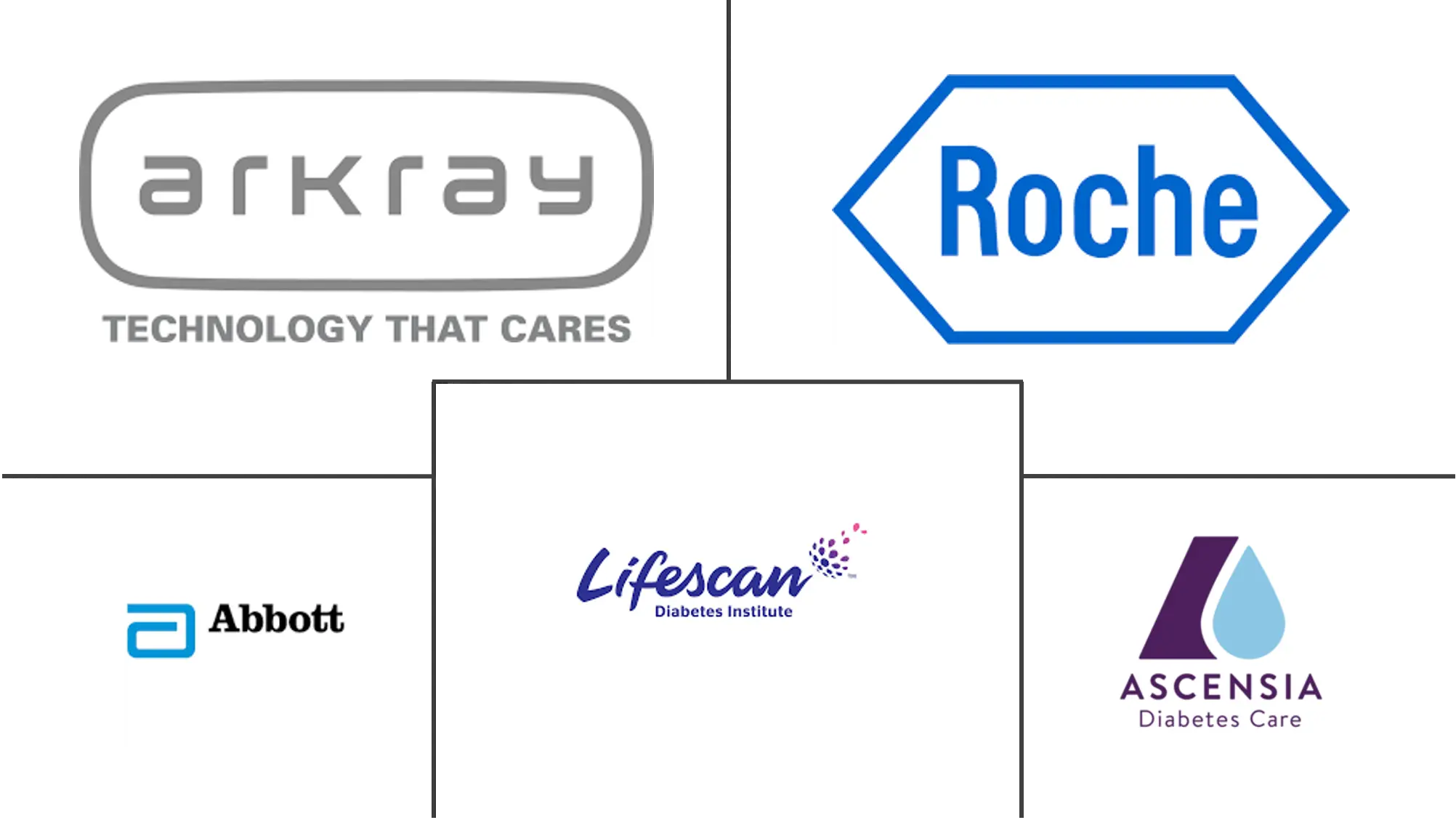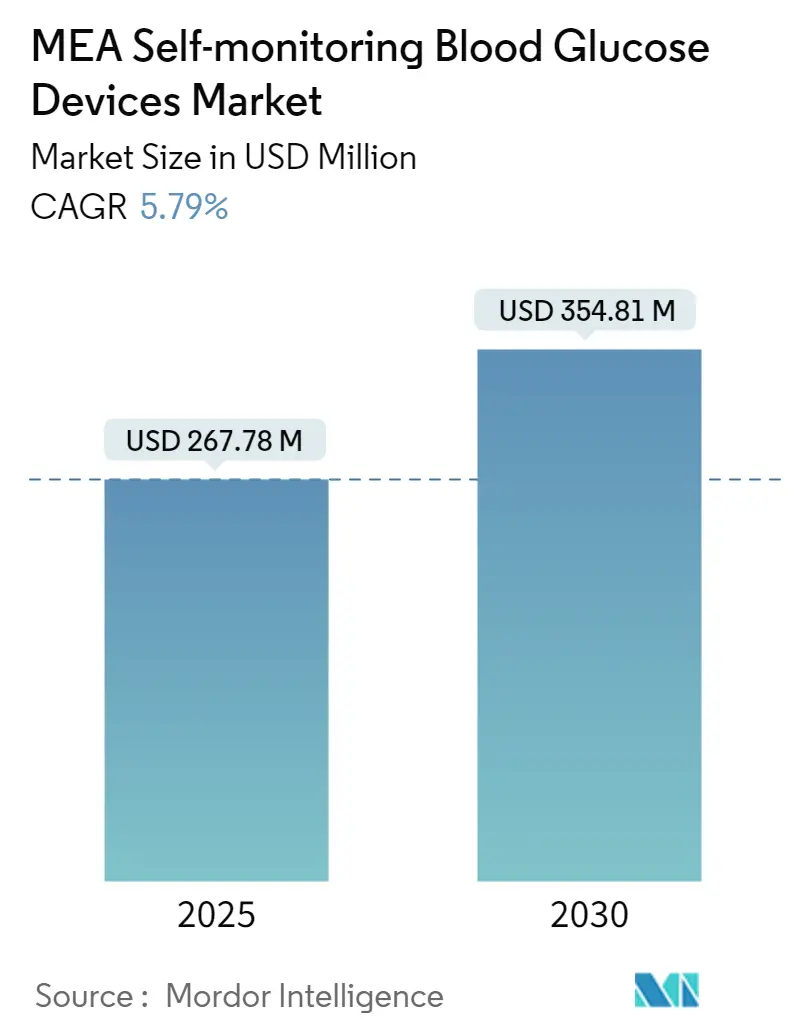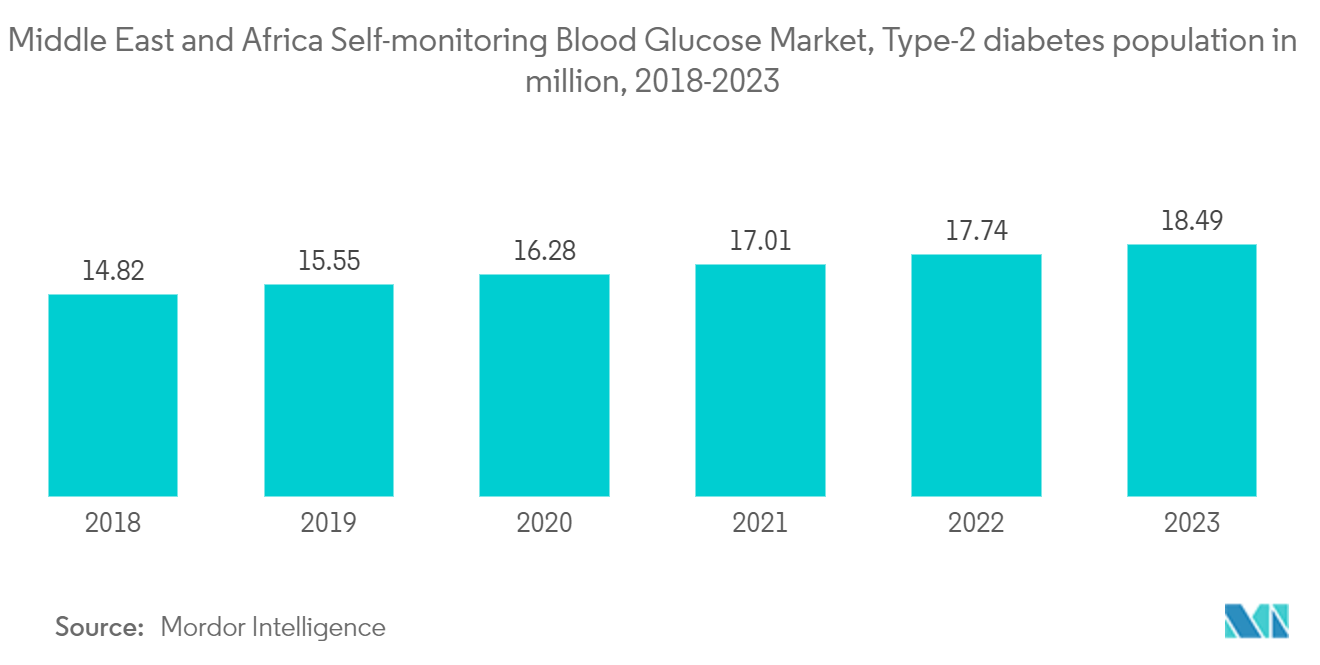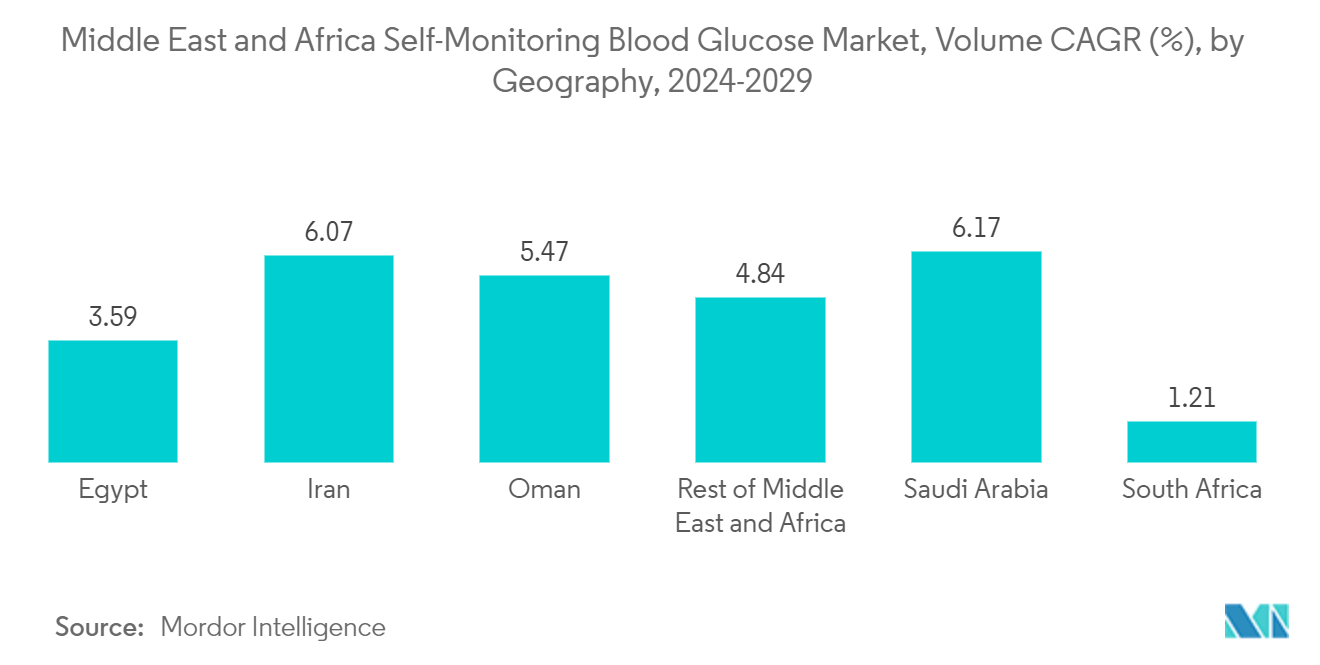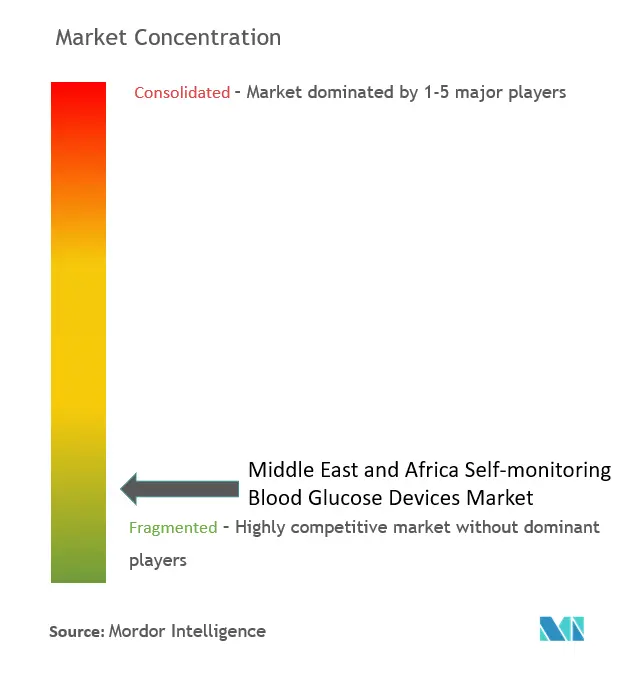MEA Self-monitoring Blood Glucose Devices Market Analysis
The MEA Self-monitoring Blood Glucose Devices Market size is estimated at USD 267.78 million in 2025, and is expected to reach USD 354.81 million by 2030, at a CAGR of 5.79% during the forecast period (2025-2030).
The Middle East and African region had witnessed an alarming increase in the prevalence of diabetes, in recent years, the rate of diabetes is at an all-time high, mainly due to lifestyle changes. Diabetes is associated with many health complications.
Patients with diabetes require many corrections throughout the day to maintain nominal blood glucose levels, such as administering additional insulin or ingesting additional carbohydrates by monitoring their blood glucose levels. Diabetes poses an emerging healthcare burden across the region.
Governments in the Middle East identified the threat of diabetes and started to respond with various policies, initiatives, and programs. Six out of 15 countries in this region still do not contain a national operational action policy for diabetes.
Many countries still do not include a national strategy to reduce overweight, obesity, and physical inactivity, which are important risk factors for diabetes. Most counties fully implemented national diabetes treatment guidelines. However, constant measures are being taken to minimize diabetic complications. Therefore, the studied market is anticipated to grow due to the factors above.
Owing to the aforementioned factors the studied market is anticipated to witness growth over the analysis period.
MEA Self-monitoring Blood Glucose Devices Market Trends
Test strips Segment holds Highest Market Share in the current year
Blood glucose test strips are small disposable strips and a key component of blood glucose testing. When blood is placed onto the test strip, it reacts with a chemical called glucose oxidase producing gluconic acid from the glucose in the blood. At the other end of the test strip, the meter transfers a current to the test strip. The test strip includes electric terminals, which allow the meter to measure the current between the terminals.
The current between the terminals changes depending on the level of gluconic acid produced. The blood glucose meter then uses an algorithm to work out the blood glucose level based on the difference in current.
The growth in market volume and share of test strips are expected to be higher than that of glucose meters because of the difference in use-case frequency. The Glucometer is a one-time purchase. However, test strips, on the other hand, are a continuous investment, as a test strip needs to be disposed of after one use.
Thus, it presents a considerable cost impact to the consumers. The market's growth is expected to be spurred by the rising diabetic population. While an average glucose meter lasts anywhere between six months and three years, presenting a one-time cost, during the same time frame, the corresponding use of multiple (in the range of thousands) test strips may occur, causing a recurrent cost impact. Overall, the demand for blood glucose test strips is projected to grow significantly over the forecast period.
Saudi Arabia is expected to register highest CAGR in the Middle East and Africa Self-monitoring Blood Glucose Market over the forecast period
More than one in ten people in Saudi Arabia is living with diabetes, and the prevalence of the disease will almost double by 2045, according to the International Diabetes Federation 2021 report. The report mentioned that 4.27 million people in Saudi Arabia include diabetes. The rise in the number of people with type 2 is driven by a complex interplay of socio-economic, demographic, environmental, and genetic factors. Key contributors include urbanization, an aging population, decreasing levels of physical activity, and increased levels of overweight and obesity.
Saudi Government in July 2022 announced that Saudi Arabia saw a growing demand for quality healthcare services spurred by changes, including an increasing and aging population and a growing prevalence of lifestyle diseases such as diabetes and obesity.
The government and private sector are involved in working on healthcare entities, certifications, and regulations. The government is taking steps to include 100% of Saudi citizens covered by insurance. They are working towards ensuring affordability, access, and quality digital healthcare and primary care with cost-effectiveness.
Therefore, owing to the factors above, the growth of the studied market is anticipated in the Middle East and Africa Region.
MEA Self-monitoring Blood Glucose Devices Industry Overview
The Middle East and African self-monitoring blood glucose devices market is fragmented, with few major manufacturers boasting a global market presence. In contrast, the remaining manufacturers are confined to other local regions.
MEA Self-monitoring Blood Glucose Devices Market Leaders
-
Platinum Equity (LifeScan)
-
Abbott Diabetes Care
-
Ascensia Diabetes Care
-
ARKRAY Inc.
-
Roche Diabetes Care
- *Disclaimer: Major Players sorted in no particular order
MEA Self-monitoring Blood Glucose Devices Market News
- October 2023: the World Health Organization (WHO) unveiled an updated list of essential diagnostics, which included new guidelines for personal use glucose meters. The WHO advised incorporating personal use glucose monitoring devices into the existing medical recommendations for diabetes.
- June 2022: LifeScan announced that the peer-reviewed journal Diabetes Technology and Therapeutics published real-world evidence of improved glycemic control in people with diabetes using a Bluetooth-connected Blood Glucose Meter with Mobile Diabetes Management Application. It can be done using the OneTouch Reveal mobile app with the OneTouch Verio Reflect meter synced via Bluetooth wireless technology. It could support improved glycemic control for people with diabetes.
MEA Self-monitoring Blood Glucose Devices Industry Segmentation
Self-monitoring blood glucose devices is an important aid for diabetic patients. Patients with diabetes can measure their blood glucose to detect hypoglycemia, adjust insulin doses as needed, and establish the response to nutrition and pharmacotherapy. The middle east and african self-monitoring blood glucose devices market are segmented into components and geography. The report offers the value (in usd) and volume (in units) for the above segments.
| Component | Glucometer Devices |
| Test Strips | |
| Lancets | |
| Geography | Egypt |
| Iran | |
| Saudi Arabia | |
| Oman | |
| South Africa | |
| Rest of Middle East and Africa |
MEA Self-monitoring Blood Glucose Devices Market Research FAQs
How big is the MEA Self-monitoring Blood Glucose Devices Market?
The MEA Self-monitoring Blood Glucose Devices Market size is expected to reach USD 267.78 million in 2025 and grow at a CAGR of 5.79% to reach USD 354.81 million by 2030.
What is the current MEA Self-monitoring Blood Glucose Devices Market size?
In 2025, the MEA Self-monitoring Blood Glucose Devices Market size is expected to reach USD 267.78 million.
Who are the key players in MEA Self-monitoring Blood Glucose Devices Market?
Platinum Equity (LifeScan), Abbott Diabetes Care, Ascensia Diabetes Care, ARKRAY Inc. and Roche Diabetes Care are the major companies operating in the MEA Self-monitoring Blood Glucose Devices Market.
What years does this MEA Self-monitoring Blood Glucose Devices Market cover, and what was the market size in 2024?
In 2024, the MEA Self-monitoring Blood Glucose Devices Market size was estimated at USD 252.28 million. The report covers the MEA Self-monitoring Blood Glucose Devices Market historical market size for years: 2019, 2020, 2021, 2022, 2023 and 2024. The report also forecasts the MEA Self-monitoring Blood Glucose Devices Market size for years: 2025, 2026, 2027, 2028, 2029 and 2030.
Our Best Selling Reports
MEA Self-monitoring Blood Glucose Devices Industry Report
Statistics for the 2025 MEA Self-monitoring Blood Glucose Devices market share, size and revenue growth rate, created by Mordor Intelligence™ Industry Reports. MEA Self-monitoring Blood Glucose Devices analysis includes a market forecast outlook for 2025 to 2030 and historical overview. Get a sample of this industry analysis as a free report PDF download.

